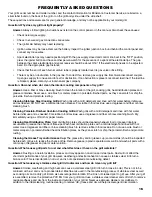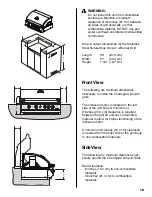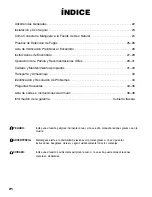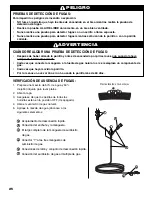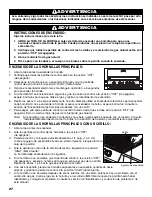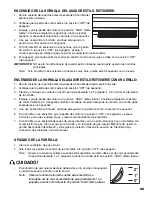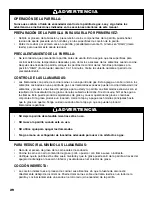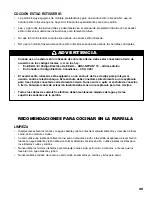
16
Your grill's serial number and model number, and the contact information for Brinkmann Customer Service, are listed on a
silver label found on the back of the grill or on the grill body side, under the side shelf.
These questions and answers are for your general knowledge, and may not be applicable to your model grill.
Question: Why does my grill not light properly?
Answer:
Always follow lighting instructions as listed on the control panel or in this manual. Also check these causes:
•
Check natural gas supply.
•
Check to ensure all gas connections are secure.
•
The igniter AA battery may need replacing.
•
Ignition wires may be loose. Remove the battery, inspect the igniter junction box found behind the control panel and
connect any loose wires.
•
Spark electrode tips may need repositioning. With the gas supply closed and control knob set to the "OFF" position,
press the igniter button and have another person watch for the presence of a spark at the electrode tips. The gap
between the spark electrode tip and spark receiver should be about 3/16". If the electrode tip needs to be adjusted,
bend it to the appropriate gap distance.
•
Check that the end of each burner venturi tube is properly located over its gas valve orifice fitting.
•
There may be an obstruction in the gas line. To correct this, remove gas supply line from Quick-disconnect coupler.
Open gas supply for one second to test for obstruction. If no obstruction is present, reconnect fuel line. If the fuel line
is blocked, please contact your local natural gas company.
Question: How and when do I clean the interior cooking components of my grill?
Answer:
Use a fiber or brass cleaning brush to clean the interior of the grill, cooking grills, heat distribution plates and
grease containers. Never use a wire brush or metal scraper on porcelain-finished parts, as they can scratch or chip the
porcelain finish and promote rusting.
Cleaning Stainless Steel Cooking Grills:
Wash grills with a mild detergent and rinse with hot water before initial use
and as needed. DO NOT use a commercial oven cleaner. For stubborn food residue, use a degreaser and fiber or brass
cleaning brush.
Cleaning Porcelain-Finished Cast-Iron Cooking Grills:
Wash grills with a mild detergent and rinse with hot water
before initial use and as needed. For stubborn food residue, use a degreaser and fiber or brass cleaning brush. Dry
immediately using a soft cloth or paper towels.
Cleaning Heat Distribution Plate:
Heat distribution plates should be cleaned whenever food or grease drippings
accumulate to reduce the chance of flare-ups. Wash heat distribution plates with a mild detergent and rinse with hot
water. Use a degreaser and fiber or brass cleaning brush to remove stubborn food residue. Do not use a wire brush or
metal scraper on porcelain-finished heat distribution plates, as they can scratch or chip the porcelain finish and promote
rusting.
Cleaning the Grease Tray and/or Grease Cup:
The grease tray and/or grease cup (some models) should be inspected
before each grill use to reduce the chance of fire. Remove grease (a plastic spatula works well) and wash all parts with a
mild soap or degreaser and warm water solution.
Question: What causes grill parts to rust and what effect does it have on the grill materials?
Answer:
Rusting is a natural oxidation process and may appear on cast-iron and steel parts. Rust will not affect the
short-term performance of your grill. However, weathering and extreme heat can cause a stainless steel lid to turn a
bronze color. This is discoloration, not rust, and is not considered a manufacturing defect.
Question: What causes my stainless steel grill lid to discolor and how do I clean my grill lid?
Answer:
Smoke, weathering and high heat can cause a stainless steel grill lid to turn bronze in color. This is not to be
confused with rust and is not a product defect. Machine oils used in the manufacturing process of stainless steel as well
as cooking oils and a dirty grill lid can also encourage discoloration if the lid is not cleaned prior to grill use. After your grill
is assembled, remove the protective PVC film from your grill lid and use a stainless steel cleaner and soft cloth to remove
residual adhesive and oils from the inside and outside of your grill lid. Never use abrasive cleaners or scrubbers. In
addition to the initial cleaning, routine cleaning to remove dirt, grease and oils will help discourage lid discoloration.
FREQUENTLY ASKED QUESTIONS















